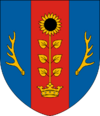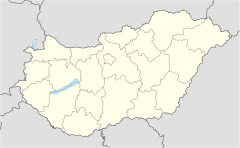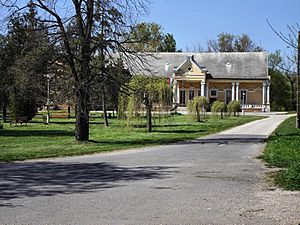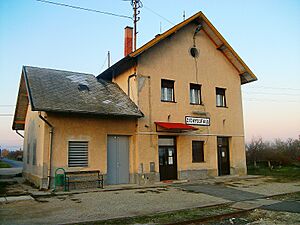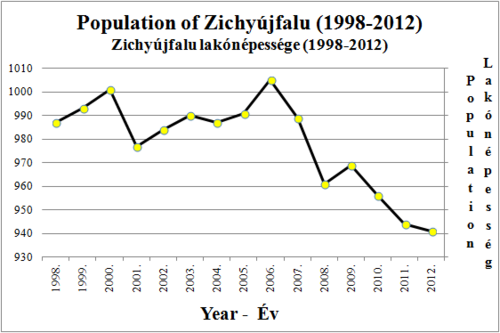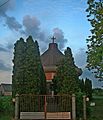Zichyújfalu facts for kids
Quick facts for kids
Zichyújfalu
Villa Nova
|
||
|---|---|---|
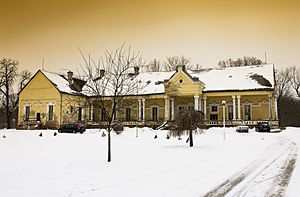
Zichy Mansion
|
||
|
||
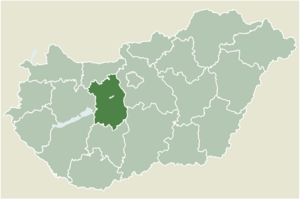
Location of Fejér county in Hungary
|
||
| Country | ||
| County | Fejér | |
| Area | ||
| • Total | 10.82 km2 (4.18 sq mi) | |
| Elevation | 125 m (410 ft) | |
| Population
(2014)
|
||
| • Total | 909 | |
| • Density | 84.011/km2 (217.59/sq mi) | |
| Time zone | UTC+1 (CET) | |
| • Summer (DST) | UTC+2 (CEST) | |
| Postal code |
8112
|
|
| Area code(s) | 22 | |
Zichyújfalu is a village located in Fejér county, Hungary. It is about 10 kilometers away from Lake Velencei. You can easily reach it by road or by train using the Pusztaszabolcs-Székesfehérvár line.
This village used to be part of Gárdony. However, in December 1997, it became an independent village. The first time Zichyújfalu was mentioned in writing was in 1239. Back then, it was called Villa Nowa (Nova). It belonged to the Vértes estates of the Csák family. Later, in 1447, it was known as Wyfalw (Újfalu).
The Zichy family became the landowners in Újfalu during the time of the Turkish rule. After the Turks left, farmers from Seregélyes rented the land for a while. In 1784, János Zichy, who owned the land, built a castle in Újfalu. He also created a deer park there. The name "Zichy" in the village's name comes from this important family. The Zichy family's old hunting home is still in the village. Today, it serves as the Mayor's Office. You can see the building from the outside, and its park is a nice place to relax.
Contents
A Look at Zichyújfalu's Population
The number of people living in Zichyújfalu has changed over time. Understanding these changes helps us learn about the village's growth.
The History of Zichyújfalu
The name Újfalu means "newly founded settlement." The "Zichy" part of the name refers to the Zichy family, who owned the land a long time ago.
Early Records and Landowners
The village was first mentioned in writing in 1239 as Villa Nowa (Nova). It was part of the Vértes estate. In 1447, it was called Wyfalw (Újfalu). The Zichy family became the landowners during the time of the Turkish Conquest. After the Turks were gone, the land was rented to farmers from Seregélyes. In 1784, Ferenc Zichy became the landowner. At that time, Újfalupuszta had six houses with 18 families, totaling 91 people.
Growth and Challenges in the 19th Century
In the mid-1800s, Újfalupuszta (which became Zichyújfalu in 1898) was not developing quickly. Progress was slow because the village depended on the large feudal estate. Most people living there worked as household servants or daily laborers. There were no peasant farmers who owned their own land.
The number of people living in the village depended on how much work was available. The landowner lived in Seregélyes and owned several other farms nearby. The Újfalu farmstead was very large, mostly used for growing crops and for meadows.
Economic Changes and Social Life
The Zichy family started to develop their estate in the 1870s. They realized the land was very fertile. Growing corn and raising animals were the main jobs. Workers were often paid with goods instead of money. Even though the Zichy family made a lot of money, it didn't always help the workers. Many workers came from Seregélyes, and their protests often happened at the same time as those in Seregélyes.
János Zichy built a mansion in Újfalu and created a menagerie (a collection of wild animals). He also helped build the Székesfehérvár-Pusztaszabolcs railway line. He even planned to build a post office in the village.
Cultural life was mainly influenced by the church. Most people were Roman Catholic, with a smaller group of Calvinists. Both groups were managed from Seregélyes until 1949. The Roman Catholics ran the school, but children from Calvinist families could also attend. For a while, there was no permanent school in the village.
Modernization and Independence
A loading platform at the railway station and a narrow-gauge railway line made it easier to sell farm products. Around 1900, the capital city became the main market for products from Újfalu.
During World War I, János Zichy leased his estate to others. In October 1918, there was a lot of tension in the village. During the Soviet republic in 1919, the farm became an independent cooperative.
Zichyújfalu was in the middle of World War II fighting from 1944 until March 21, 1945. The people had to leave their homes for safety.
After the war, in 1946, the village wanted to become independent. However, authorities in Seregélyes and the county did not agree. People found jobs on the state farm, which helped the village financially. New workers moved to the village, and the population grew. They were given jobs, homes, and land to build on.
Because the population grew, it became harder to manage the village from Seregélyes. A new school building was built from 1957 to 1959 and is still used today. In 1956, Újfalu was connected to the national electricity network.
The population kept growing, leading to more changes. About 80% of the villagers worked for the State Farm of Agárd. Both Agárd and Gárdony had a big influence on Újfalu. On September 14, 1962, the villagers voted to join Gárdony. A large part of Újfalu's land was added to Gárdony.
After joining Gárdony, the village developed. New streets were built and paved, and sidewalks were added. Villagers helped with this development by doing a lot of volunteer work. Shopping also improved. However, in the 1970s, people started to leave the village.
After the political system changed, this trend slowed down. It became harder to find jobs in nearby factories. Transport became a problem, making it difficult for people to reach the administrative center. Villagers felt that the joint local government of Gárdony and Zichyújfalu was not paying enough attention to their needs. They believed a new local government would focus more on Zichyújfalu.
The village also had the economic means to become independent. So, on December 15, 1997, Zichyújfalu officially became an independent village.
Important Places in Zichyújfalu
The Zichy Mansion
The Zichy family built their mansion in Zichyújfalu in 1784. It was first called the Little Castle. Later, after a larger mansion was built, it became the farm manager's home. The main Zichy palace was built between 1891 and 1894. It was designed in an "eclectic style," meaning it combined different architectural ideas.
The mansion used to be shaped like a "U," but its right side was destroyed during World War II. It was once surrounded by a large park of 28 acres. In front of the main part of the building, there is a porch with 14 double columns.
Education in Zichyújfalu
The elementary school in Zichyújfalu is called the István Fekete Primary School. It has been named after the writer István Fekete since 1992. This school is part of a larger educational group that includes the Agárd Chernel István Elementary School.
Images for kids
-
Ady Endre street.
See also
 In Spanish: Zichyújfalu para niños
In Spanish: Zichyújfalu para niños


